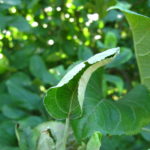- Figure 1
- Fig. 2
- Fig. 3
Since 2012, apple powdery mildew(PM) has been part of new normal of apple growing in Indiana. As many of you remember (but would like to forget), 2012 was the year when much of the state lost the crop due to a late season freeze. This was then followed by one of the driest years on record. The loss of fruit resulted in many growers greatly reducing their fungicide applications, or using just captan or mancozeb, which, although effective against scab, are not effective against powdery mildew. This led to a build-up of PM inoculum, and continued management issues surrounding this problem.
Powdery mildew symptoms can range from the subtle (Figure 1) to the incredibly obvious (Figure 2), and everything in between. As these Honeycrisp terminal buds break due to excessive rainfall, new growth is very susceptible to powdery mildew. Cover sprays should include either Pristine, Merivon or Luna Sensation, Sovran (if the PHI is acceptable), Flint, or a DMI fungicide like Rally, Indar or Topguard. In Indiana, as in many places, the following cultivars are susceptible: Jonathan, Ida Red, Cortland, Baldwin, Granny Smith, and Mutsu. We are starting to see an increase of symptoms of PM on Honeycrisp, too. Although no one cares about the foliage, PM also infects fruit, and can cause a russetting of the skin that some consumers find objectionable (Figure 3).
One of the most effective fungicides against PM is Rally, if resistance is not an issue. The strobilurins (Sovran, Flint) or the 7-11s (Merivon, Pristine, Luna Sensation) are also excellent mildewcides. Although too late for this year, sprays to control mildew should begin at tight cluster through about fourth cover.
Cold weather in winter (below -11 degrees F) will kill mildew-infected buds, reducing overwintering inoculum, and may be the only reason to hope for a cold winter!


